
The Parastacidae are the family of freshwater crayfish found in the Southern Hemisphere. The family is a classic Gondwana-distributed taxon, with extant members in South America, Madagascar, Australia, New Zealand, and New Guinea, and extinct taxa also in Antarctica.
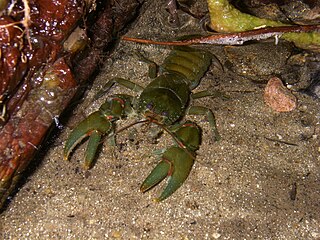
Astacoides betsileoensis is a species of crayfish in the family Parastacidae. It is endemic to Madagascar. The populations are threatened by habitat loss due to land conversion as well as harvesting for food from locals and predation from introduced species. As of 2010 there were no specific measures for conservation apart from a minimum size limit of 10 cm for harvesting. In some areas, local rules and taboos help controlling the pressure from harvesting.
Astacoides caldwelli is a species of crustacean in family Parastacidae. It is endemic to Madagascar. A. caldwelli is mostly found in rivers draining forested areas at elevations between 600 - 800m. The populations are threatened by habitat loss as well as predation by introduced species and harvesting at a subsistence level from local fishermen.

Astacoides crosnieri is a species of crustacean in family Parastacidae. It is endemic to Madagascar, being widespread in the former Province Fianatantsoa. A. crosnieri inhabits swampy areas at an elevation between 500 – 1000 m above sea level.
Astacoides granulimanus is a species of southern crawfish in the family Parastacidae.

Astacoides madagascarensis is a species of southern crawfish in the family Parastacidae.
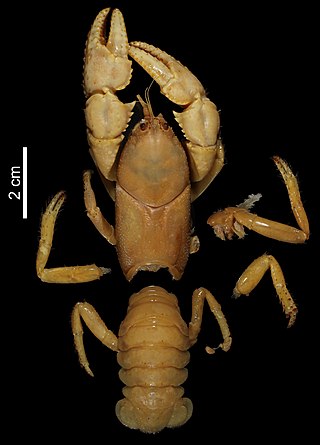
Astacoides petiti, commonly known as Orana, is a species of southern crayfish in the family Parastacidae. Along with their congeners in the genus Astacoides, they are endemic to Madagascar.
Cambarus chaugaensis, the Chauga crayfish or Chauga River crayfish, is a species of crayfish in the family Cambaridae. It is endemic to the Carolinas in the United States of America. The common and scientific names refer to the Chauga River of South Carolina, where the first specimens were collected.
Cambarus coosawattae, the Coosawattae crayfish, is a species of crayfish in the family Cambaridae. It is endemic to Georgia. The common name refers to the Coosawattee River, with the original specimens being collected in the Cartecay River which combines with another river to form the Coosawattee.
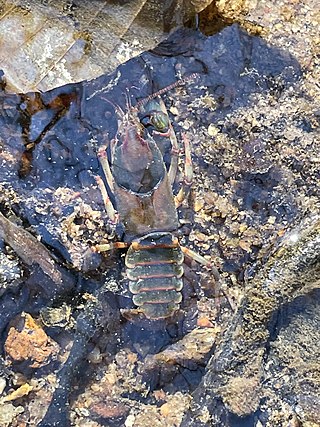
Cambarus howardi, the Chattahoochee crayfish, is a species of crayfish in the family Cambaridae. It is found in North America. The common name refers to the Chattahoochee River, where the first specimens were collected.

Lacunicambarus miltus, the rusty gravedigger, is a species of crayfish in the family Cambaridae. It is found in the southeastern United States.

Cambarus scotti, the Chattooga River crayfish, is a species of crayfish in the family Cambaridae. It is endemic to Alabama and Georgia. The common name refers to the Chattooga River. The original specimens were collected from Clarks Creek in Chattooga County.
Creaserinus danielae, the speckled burrowing crayfish, is a species of crayfish in the family Cambaridae. It is found in Mississippi, Alabama, Louisiana, and Florida.
Creaserinus gilpini, the Jefferson County crayfish, is a species of crayfish in the family Cambaridae. It is endemic to Arkansas.
Fallicambarus harpi, the Ouachita burrowing crayfish, is a species of crayfish in the family Cambaridae. It is known only in southwest Arkansas. The species is a primary burrower, located in low lying seepage areas in pastures, yards and lawns.
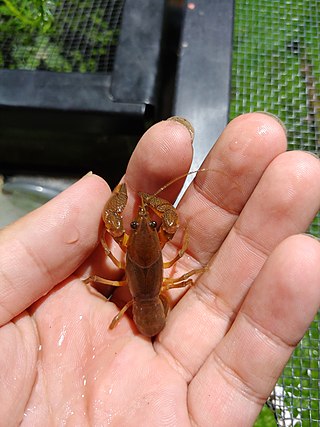
Lacunicambarus acanthura, the thornytail crayfish, is a species of crayfish in the family Cambaridae. It is found in the southeastern United States.
Astacoides hobbsi is a species of southern crawfish in the family Parastacidae.
Aenigmastacus crandalli is a species of fossil freshwater crayfish. It was found in early Eocene Okanagan Highlands lake deposits in British Columbia, and was described in 2011. It is the first member of the Gondwana-distributed family Parastacidae to be found in the Northern Hemisphere, and is the only species in the genus Aenigmastacus. Twelve specimens are known, with a total body length of 3–5 cm (1.2–2.0 in). On some specimens, details of the internal anatomy can be seen due to the exceptional preservation.
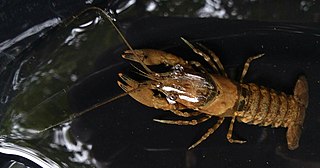
Faxonius erichsonianus is a species in the family Cambaridae ("crayfishes"), in the order Decapoda. A common name for Faxonius erichsonianus is reticulate crayfish. Faxonius erichsonianus is found in the south eastern United States of America.

Samastacus is a genus of southern crayfish in the family Parastacidae. It has a single species, Samastacus spinifrons.















